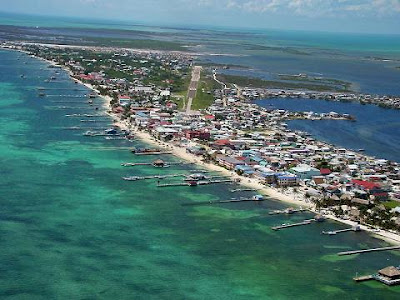The Belize Barrier Reef is a series of coral reefs straddling the coast of Belizeroughly 300 meters or 1,000 ft offshore in the north and 40 kilometers or 25 mi in the south within the country limits. The Belize Barrier Reef is a 300 kilometers or 186 mi long section of the 900 kilometers or 560 mi long Mesoamerican Barrier Reef System, which is continuous from Cancun on the northeast tip of the Yucatan Peninsula through the Riviera Maya up to Honduras. It is the second largest coral reef system in the world after the Great Barrier Reef in Australia, popular for scuba diving and snorkeling. It is Belize top tourist destination, attracting almost half of its 260,000 visitors, and vital to its fishing industry. The details of Belize Barrier Reef are explained in world tour guides below.
 Charles Darwin described it as the most remarkable reef in the West Indies in 1842. A large portion of the reef is protected by the Belize Barrier Reef Reserve System, which includes seven marine reserves, 450 cays, and three atolls. It totals 960 km² or 370 miles² in area, including Glovers Reef Marine Reserve, Great Blue Hole, Half Moon Caye, Natural Monument and Hol Chan Marine Reserve. Cayes include Ambergris Caye, Caye Caulker, Caye Chapel, St. Georges Caye, English Caye, Rendezvous Caye, Gladden Caye, Ranguana Caye, Long Caye, Maho Caye, Blackbird Caye, Three Coner Caye, Northern Caye and Sandbore Caye.
Charles Darwin described it as the most remarkable reef in the West Indies in 1842. A large portion of the reef is protected by the Belize Barrier Reef Reserve System, which includes seven marine reserves, 450 cays, and three atolls. It totals 960 km² or 370 miles² in area, including Glovers Reef Marine Reserve, Great Blue Hole, Half Moon Caye, Natural Monument and Hol Chan Marine Reserve. Cayes include Ambergris Caye, Caye Caulker, Caye Chapel, St. Georges Caye, English Caye, Rendezvous Caye, Gladden Caye, Ranguana Caye, Long Caye, Maho Caye, Blackbird Caye, Three Coner Caye, Northern Caye and Sandbore Caye.Because of its exceptional natural beauty, significant on going ecological and biological processes, and the fact that it contains the most important and significant natural habitats for in-situ conservation of biological diversity, the Reserve System has been designated as a World Heritage Site since 1996.
Despite these protective measures, the reef is under threat from oceanic pollution as well as uncontrolled tourism, shipping, and fishing. The main threats are considered to be hurricanes along with global warming and the resulting increase in ocean temperatures, which cause coral bleaching. It is claimed by scientists that over 40% of Belize's coral reef has been damaged since 1998.
The Belize Barrier Reef has been affected by two mass-bleaching events. The first mass bleaching occurred in 1995, with an estimated mortality of 10% of coral colonies, according to a report by the Coastal Zone Management Institute in Belize. In 1997 and 1998, a second mass-bleaching event occurred, coinciding with devastation effected by hurricane Mitch. Biologists observed a 48% reduction in live coral cover across the Belize reef system.

 Usually, it is hard to distinguish whether the reason for coral bleaching is human activities or natural reasons such as storms or bacterial fluctuations. But in the case of the Belize Barrier Reef, many factors which make the distinction difficult don’t apply. Human population in this area is much sparser than the corresponding areas near other coral reefs, so the human activity and pollution are much lower compared to other coral reefs and the Belize reef system is in a much more enclosed area.
Usually, it is hard to distinguish whether the reason for coral bleaching is human activities or natural reasons such as storms or bacterial fluctuations. But in the case of the Belize Barrier Reef, many factors which make the distinction difficult don’t apply. Human population in this area is much sparser than the corresponding areas near other coral reefs, so the human activity and pollution are much lower compared to other coral reefs and the Belize reef system is in a much more enclosed area.When coral bleaching occurs, a large part of the coral dies, and the remaining part of the ecosystem begins the process of repairing the damage. But the chances of recovery are low, as corals that are bleached become much more vulnerable to disease. Disease often kills more corals than the bleaching event itself. With continuous bleaching, the coral reef will have little to no chance of recovery.







No comments:
Post a Comment